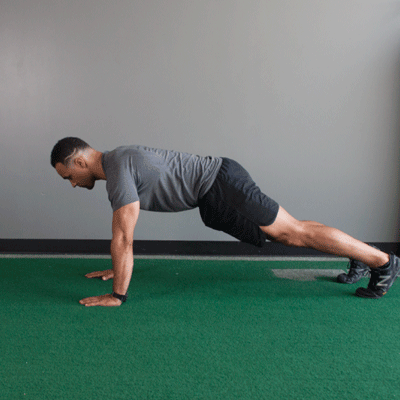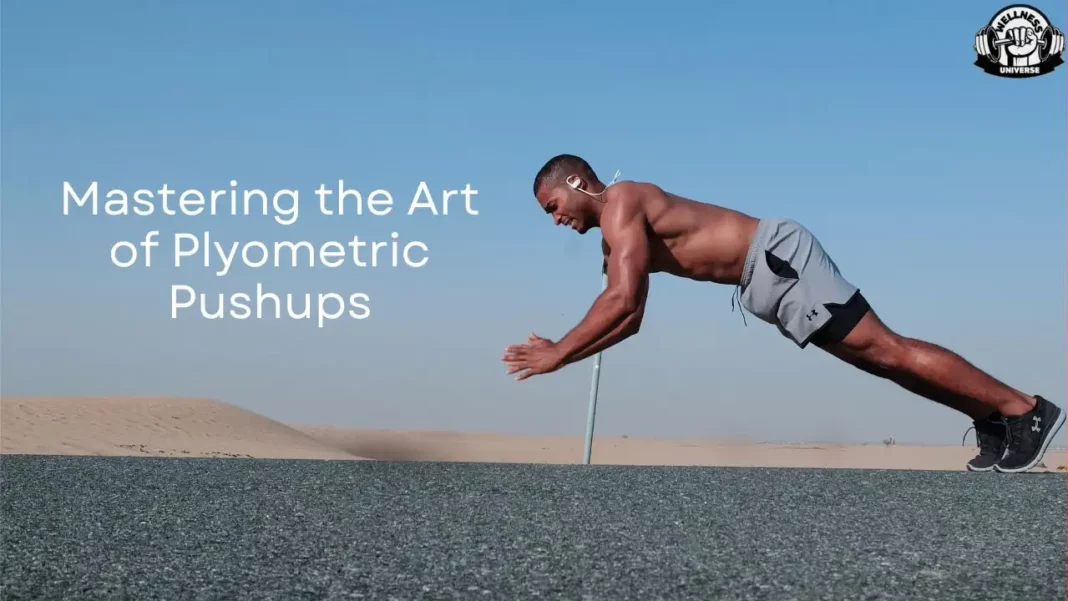Explosive Strength: Mastering the Art of Plyometric Pushups

Plyometric pushups, also known as plyo pushups, are a dynamic and explosive variation of the classic pushup exercise. Unlike traditional pushups that focus on controlled movement, plyometric pushups incorporate powerful bursts of force to propel the body off the ground.
This explosive element makes them a fantastic choice for athletes and fitness enthusiasts looking to enhance their strength, power, and overall athletic performance. In a plyometric pushup, the hands leave the ground momentarily during the upward phase, allowing the muscles to generate maximal force and engage in rapid contractions.
Plyometric training is a form of exercise that involves quick, explosive movements to improve muscular power, speed, and agility. Incorporating plyometric pushups into a workout routine can have a significant impact on athletic performance.
By challenging the muscles to generate rapid force, plyometric pushups improve the efficiency of muscle fibers and neuromuscular coordination. This translates into greater power output, which can be beneficial for sports that require explosive movements, such as basketball, soccer, and sprinting.
Additionally, plyometric pushups can enhance upper body strength and core stability, contributing to better overall physical performance.
Throughout this blog, we will explore the world of plyometric pushups in-depth, covering various essential aspects of this dynamic exercise. We will delve into different variations and progressions of plyometric pushups, allowing readers to tailor their training to their fitness levels and goals.
Safety considerations are paramount when performing plyometric exercises, and we will provide valuable tips and precautions to avoid injuries and ensure proper form. Whether you are a seasoned athlete or a fitness beginner, this blog will serve as a comprehensive guide to mastering plyometric pushups and elevating your athletic abilities.
Understanding Plyometric Pushups
Proper technique is essential when performing plyometric pushups to ensure maximum efficiency and safety. To execute a plyometric pushup, start in a high plank position with your hands placed slightly wider than shoulder-width apart. Your shoulders should be directly above your wrists, and your body should form a straight line from head to heels. Engage your core and glutes to maintain stability throughout the movement.
Bend your elbows and lower your chest toward the floor, just like in a regular pushup. However, instead of pushing back up immediately, explosively push through your palms to lift your hands off the ground. As your hands leave the floor, try to achieve enough height to allow your upper body to lift off briefly before landing softly back into the starting position. Keep your elbows slightly bent during the landing to absorb the impact.
Maintaining proper body alignment is crucial to prevent injuries during plyometric pushups. Keep your body in a straight line from head to heels throughout the entire exercise. Avoid sagging your hips or arching your back, as this can strain the lower back and compromise your form.
As for wrist protection, distribute the weight evenly through your palms and fingers to avoid excessive stress on your wrists. Consider using pushup bars or hexagonal dumbbells to elevate your hands slightly and reduce the wrist angle, especially if you have wrist sensitivity or discomfort.
Breathing plays a significant role in plyometric pushups, influencing both your performance and power generation. During the downward phase of the pushup, inhale deeply and engage your core. As you explosively push off the ground, exhale forcefully to release the air and enhance the generation of power. Coordinating your breath with the movement helps stabilize the core and assists in propelling your body upward.
Remember to maintain a smooth and controlled rhythm throughout the exercise, and avoid holding your breath at any point. By incorporating proper breathing techniques into your plyometric pushups, you optimize your performance and make the most of this dynamic and challenging exercise.
The Benefits of Plyometric Pushups

Plyometric pushups are an excellent exercise for building explosive upper-body strength and power. By adding an explosive component to the traditional pushup, the muscles in the chest, shoulders, and triceps are engaged more intensely. As you push off the ground, your muscles rapidly contract to generate maximum force, enhancing your upper body’s power output.
The explosive nature of plyometric pushups stimulates the fast-twitch muscle fibers, which are responsible for generating quick and powerful movements. As you continue to perform plyometric pushups regularly, these muscle fibers become more efficient at generating force, leading to significant gains in upper body strength.
Plyometric pushups serve as an excellent foundation for total body conditioning. Not only do they target the upper body, but they also engage the core and lower body muscles. During the explosive push-off phase, your core muscles contract to stabilize the spine and prevent excessive arching or sagging. Additionally, your glutes, quadriceps, and hip muscles play a role in maintaining proper body alignment throughout the movement.
Incorporating plyometric pushups into your workout routine complements other plyometric exercises, such as box jumps and medicine ball slams. The combination of explosive movements creates a full-body workout that improves overall athleticism, coordination, and power.
Athletes from various sports can benefit significantly from incorporating plyometric pushups into their training. The explosive upper body strength gained from plyometric pushups directly translates to improved sports performance.
For sports that require quick bursts of speed and agility, such as basketball, soccer, and tennis, plyometric pushups can enhance the ability to generate force rapidly and change direction swiftly. The fast-twitch muscle fibers developed through plyometric pushups contribute to improved quickness and reaction time, giving athletes a competitive edge on the field or court.
Furthermore, plyometric pushups can also enhance vertical jumping ability, which is crucial in sports like volleyball and basketball. The explosive power generated during plyometric pushups carries over to vertical jump height, helping athletes reach higher for rebounds or spikes.
Overall, the combination of upper body strength, total body conditioning, and sports-specific benefits makes plyometric pushups a valuable addition to any athlete’s training regimen. Whether you’re a professional athlete or a fitness enthusiast, incorporating plyometric pushups into your routine can take your physical performance to new heights.
Exploring Plyometric Pushup
Clapping pushups are an advanced variation of plyometric pushups that take explosive upper-body strength to the next level. During a clapping pushup, you explosively push off the ground with enough force to lift your hands off the floor and perform a quick clap before catching yourself back in the pushup position. This explosive movement requires even more power and coordination than traditional plyometric pushups.
To perform clapping pushups safely, it’s essential to have a strong foundation in standard plyometric pushups. Make sure your form and technique are solid before attempting clapping pushups. As with any plyometric exercise, start with a few repetitions and gradually increase the number as you become more proficient and confident in the movement.
Incorporating additional equipment such as medicine balls and resistance bands can add variety and challenge to plyometric pushups. Performing plyometric pushups with a medicine ball involves placing one or both hands on the ball during the pushup phase. This variation increases instability, requiring the core muscles to work harder to maintain balance and control throughout the movement.
Resistance bands can also be utilized to add resistance and intensity to plyometric pushups. By looping a resistance band around your back and holding the ends in each hand, you create additional resistance as you push off the ground. This variation targets the chest, shoulders, and triceps while engaging the muscles of the back and core.
Both medicine ball and resistance band plyometric pushups offer unique benefits and can be tailored to individual fitness levels. As with any new exercise variation, start with a comfortable level of resistance or difficulty and progress gradually as you build strength and confidence.
Plyometric pushups may seem intimidating for beginners, but there are modified versions that cater to different fitness levels. The key is to start with a variation that challenges you appropriately while maintaining proper form and technique.
One modified version for beginners is the kneeling plyometric pushup. Instead of starting in a full plank position, begin on your knees with your hands placed slightly wider than shoulder-width apart. Lower your chest towards the ground, then explosively push off the floor, lifting your hands off the ground for a moment before returning to the starting position. This variation reduces the amount of bodyweight resistance, making it more manageable for beginners to build upper body strength and coordination.
Another beginner-friendly variation is the incline plyometric pushup. This variation involves placing your hands on an elevated surface, such as a sturdy box or bench, while maintaining a plank position with your feet on the ground. Lower your chest towards the elevated surface, then push off with enough force to lift your hands off the box. The incline reduces the intensity of the pushup, making it more accessible for those new to plyometric exercises.
By starting with appropriate modifications and gradually progressing to more challenging variations, individuals of all fitness levels can safely incorporate plyometric pushups into their workout routines. As you gain strength and confidence, you can continue to explore different plyometric pushup variations to keep your workouts dynamic and effective.
Safety Considerations and Precautions
Before engaging in plyometric pushups or any other explosive exercises, it is crucial to warm up properly. A thorough warm-up routine helps increase blood flow to the muscles, improves joint mobility, and enhances overall performance. Begin with light cardiovascular exercises such as jogging, jumping jacks, or dynamic stretches to get your heart rate up and warm up the major muscle groups.
After the general warm-up, perform specific dynamic stretches that target the muscles involved in plyometric pushups. Dynamic stretches are active movements that mimic the exercises you’ll be performing, gradually increasing the range of motion and muscle activation. Examples of dynamic stretches for plyometric pushups include arm circles, chest openers, and shoulder rotations.
While plyometric pushups offer many benefits, they can also pose some risks, especially if performed incorrectly or without proper preparation. Common injuries associated with plyometrics include wrist strains, shoulder issues, and muscle sprains.
To reduce the risk of injury during plyometric pushups, ensure that you maintain proper form throughout the exercise. Keep your wrists aligned with your shoulders and avoid bending them excessively during the explosive phase. Engage your core muscles to stabilize your body during the pushup and landing phases.
Additionally, avoid overtraining and listen to your body. Plyometric exercises put significant stress on your muscles and joints, so it’s essential to allow adequate rest and recovery between workouts. If you experience pain or discomfort during or after plyometric pushups, it’s a sign that you may need to scale back or take a break from this exercise until the discomfort subsides.
Plyometric exercises, including plyometric pushups, place substantial stress on the body’s muscles and connective tissues. Overtraining or neglecting rest days can lead to overuse injuries and hinder progress. It is essential to listen to your body and recognize signs of fatigue or overexertion.
If you are new to plyometric pushups or have been inactive for a while, start with the modified variations discussed earlier to gradually build strength and coordination. As you progress, incorporate plyometric pushups into your routine with appropriate sets and repetitions. Avoid performing plyometric pushups on consecutive days, as your muscles need time to recover and repair.
If you experience persistent pain or discomfort in your wrists, shoulders, or chest, it’s essential to consult a fitness professional or healthcare provider. They can provide personalized advice and help you identify any form of issues that may be contributing to discomfort.
By incorporating proper warm-up routines, maintaining correct form, and giving your body the time it needs to recover, you can safely enjoy the benefits of plyometric pushups while minimizing the risk of injury and overuse. Remember that fitness is a journey, and it’s essential to progress at a pace that suits your individual fitness level and goals.
In Crux
Incorporating plyometric pushups into your fitness routine can be a game-changer when it comes to unlocking your athletic potential. By harnessing the power of explosive movements, plyo pushups can help you develop the strength, speed, and power needed to excel in various sports and physical activities. Whether you’re an athlete looking to enhance your performance on the field or an everyday fitness enthusiast seeking to take your workouts to new heights, plyometric pushups can be a valuable addition to your training arsenal.
One of the most appealing aspects of plyometric pushups is their versatility. They can be tailored to suit individuals of all fitness levels, from beginners to seasoned athletes. As you progress and become more proficient, you can explore various plyometric pushup variations and progressions to continue challenging your body and achieving new milestones.
Beyond the physical benefits, plyometric pushups can also invigorate your workout routine, adding an element of excitement and dynamism. They can inject a fresh burst of energy into your training, keeping you engaged and motivated to push yourself further.
However, it’s essential to remember that mastering plyometric pushups requires patience, dedication, and a commitment to proper form and safety. Start with the modified variations and gradually progress to more advanced techniques. Take the time to warm up adequately and listen to your body, ensuring that you rest and recover as needed.
As with any fitness endeavor, consistency is key. Embrace the journey of learning and growing with plyometric pushups, celebrating each achievement along the way. Whether you’re aiming to improve your athletic performance, enhance your overall strength, or simply challenge yourself to reach new heights, plyometric pushups can serve as a valuable tool in your fitness journey.
In conclusion, plyometric pushups offer a unique and effective way to build explosive upper body strength, enhance athletic performance, and take your fitness to the next level. Embrace the challenge, stay committed to proper training, and watch as your athleticism and fitness soar to new heights with the power of plyometric pushups. With dedication and perseverance, you can unlock your athletic potential and experience the incredible benefits of this dynamic exercise in your fitness journey.
FAQs about Plyometric Pushups
Are plyometric pushups suitable for all fitness levels, including beginners?
While plyometric pushups can be challenging, they can be adapted for various fitness levels. Beginners can start with modified versions, such as kneeling plyometric pushups, to build strength and technique before progressing to the full plyometric variation. It's crucial to master proper pushup form and develop sufficient upper body strength before attempting plyo pushups to reduce the risk of injury.
How do plyometric pushups benefit the body and enhance athletic performance?
Plyometric pushups are highly effective for building explosive upper body strength. They target the chest, shoulders, and triceps while also engaging the core and stabilizing muscles. This increased power output can enhance athletic performance, benefiting activities that require quick and forceful upper body movements, such as throwing, swinging, or pushing.
What are some variations and progressions of plyometric pushups?
Several variations and progressions of plyometric pushups exist, allowing individuals to tailor their training to their fitness level. Some examples include clap pushups, where you clap your hands while airborne, and plyometric pushups with medicine balls or resistance bands for added resistance.
Can plyometric pushups help in building explosive upper body strength?
Absolutely. Plyometric pushups primarily target the upper body muscles, including the chest, shoulders, and triceps. The explosive nature of the exercise activates fast-twitch muscle fibers, which are essential for generating power and speed. Consistent practice of plyometric pushups can lead to significant gains in explosive upper body strength.
Are there any safety considerations or precautions when performing plyometric pushups?
Yes, safety is paramount when performing plyometric pushups. Ensure you have mastered the proper pushup form before attempting the explosive variation. Warm up adequately to prepare your muscles and joints for the increased demands of plyometric exercises. Listen to your body and avoid overtraining. If you have any pre-existing injuries or medical conditions, consult a fitness professional or healthcare provider before incorporating plyometric pushups into your routine.
How do plyometric pushups contribute to improving power and speed in sports?
Plyometric pushups enhance power and speed by training your muscles to generate force quickly. The explosive movement activates your fast-twitch muscle fibers, which are responsible for rapid contractions. This increased power output translates to improved performance in sports that require explosive upper body movements, such as basketball, tennis, or martial arts.
What muscle groups are targeted during plyometric pushups?
Plyometric pushups primarily target the pectoral muscles (chest), deltoids (shoulders), and triceps (back of the upper arms). Additionally, the core and stabilizing muscles play a crucial role in maintaining balance and control during explosive movement.
Can plyometric pushups be integrated into a full-body workout routine?
Absolutely. Plyometric pushups can be incorporated into a full-body workout routine as part of your upper body training. They work well in combination with other exercises like squats, lunges, and planks to create a well-rounded workout that targets various muscle groups.
How can I incorporate plyometric pushups into my training to boost performance?
To incorporate plyometric pushups into your training, start with modified versions to build strength and technique. As you progress, add plyometric pushups to your upper body workout routine 1-2 times per week. Gradually increase the number of sets and repetitions while maintaining proper form. Always prioritize rest and recovery to allow your muscles to repair and grow stronger. As you become more proficient, explore different variations and progressions to keep challenging yourself and continuously improve your athletic performance.

Meet Pradeep Singh, your go-to guide for all things fitness, health, and motivation. With over 7 years in the field, Pradeep brings a blend of expertise and real-world experience to his writing. From workout tips to healthy living insights, he simplifies complex topics, making fitness accessible for everyone. His authentic approach and genuine passion aim to inspire and support your wellness journey. Get ready to embark on a path to a healthier lifestyle with Pradeep as your trusted companion and motivator.



















